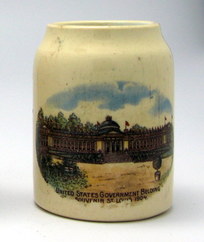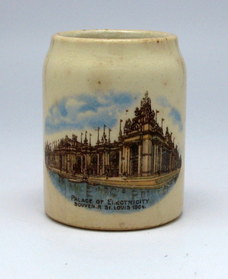World's Fairs, Carnivals, & Expositions
1904 St. Louis World's Fair
United States Government Building,
St. Louis, MO

1904 W/ Striker
From 1851 to 1915, a number of World's Fairs were held in Europe and America. World, Fairs offered an opportunity for people to exchange ideas and information while seeing first hand the latest advances in arts, sciences, inventions, and agriculture which helped propel the world into the Industrial Revolution and Twentieth Century.
The United States Government Building exhibited artifacts from the Smithsonian Institute, a complete dinosaur, guns, cannons, and a "half" of a full size battleship. The building was the largest exhibit building ever erected by government authority and every department of the United States Government was represented with elaborate displays.
The United States Government Building exhibited artifacts from the Smithsonian Institute, a complete dinosaur, guns, cannons, and a "half" of a full size battleship. The building was the largest exhibit building ever erected by government authority and every department of the United States Government was represented with elaborate displays.
Palace of Electricty,
St. Louis, MO

1904 W/ Striker
The Palace of Electricity was devoted to exhibits from the Department of Electricity. It was built at a cost of $400,000 and covered approximately eight acres, including its court yard. Its exhibits were considered "the center of attraction for all who are concerned in electrical progress." Thomas Edison is noted to have overseen the proper setup of the electrical exhibits in the fair. One of the most popular exhibits of the time, was an electric broiler which could cook a steak on both ends at the same time in only 6 minutes.
Palace of Liberal Arts,
St. Louis, MO

1904 W/Striker
The Palace of Liberal Arts occupied a nine-acre building in the extreme eastern part of the grounds devoted to exhibits classified as "Liberal Arts." It cost $475,000 to build. Objects such as models of famous lighthouses, a coin collection from the British Mint, photography exhibits, and musical instruments were on display. China contributed a large display of ancient books, carvings, rare trophies from the Chinese temples, Chinese armor, and weapons. Modern printing machinery of all kinds were in operation, including an engraving plant and lithographic presses. Other exhibit showed the development of the typewriter and Germany had an exhibit of fine printing, specimens of photography, maps, and models. The great organ in the Festival Hall was classified as one of the exhibits in Liberal Arts.



